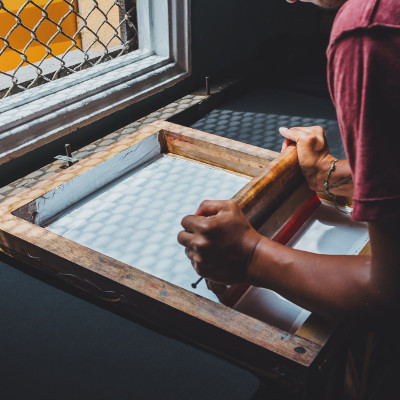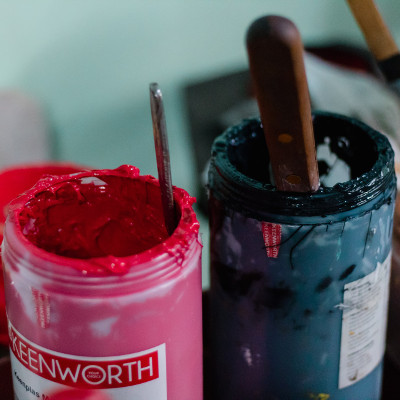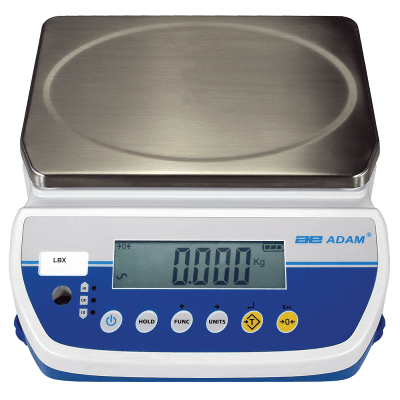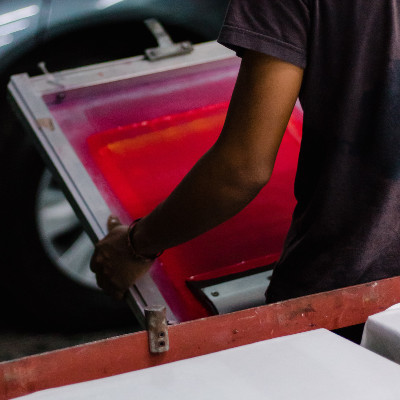
Screen printers need to carefully measure ink to get the right colors. Among the equipment needed to get consistent results, a good scale is high on the list. Let’s look at the importance of using a scale for ink mixing and which type of scale you should use for screen printing applications.
What is screen printing?
Screen printing (also called silk screening) is a method of printing graphics onto various materials (most notably T-shirts and banners) using thick ink laid on top of the fabric (as opposed to soaking the fabric in ink or dye).
How does screen printing work?
The screen printing process starts with a frame (usually wooden) containing a tightly stretched mesh. The mesh used to be made from silk (hence the name) but nowadays is usually made of polyester or similar fabric.
The mesh (or screen) is then prepared and coated with emulsion, a light-sensitive fluid. The emulsion stops the ink from going through the screen. The inks are then mixed to obtain the desired colors. The fabric that will get the graphic is placed in a machine with the inked screen. The screens are lowered and pressed into the fabric by the machine, and the ink is transferred from the screen to the fabric. Depending on the design and the colors, the fabric could undergo this process multiple times before the fabric is dried. Please keep in mind that this is a simplified version of the process.

Why use screen printing?
While there are other techniques that work well for more complex graphics (like heat transfer), screen printing is still widely used today. The thickness of the ink makes it difficult to create complex multi-color graphics, but the colors are very bright, the texture pleasant, and the product lasts longer (if you’ve ever seen a cheap graphic shirt’s images disintegrate after a few washes, you’ll understand why screen printing can be the better option). Unlike other printing techniques, screen printing stands out even on darker colors. It’s also more affordable in large quantities, which makes it popular for large businesses and schools. Screen printing is a little more complex and takes longer than other methods, so it’s usually done by trained professionals, but the quality can be worth the wait. You can usually tell if something was screen printed when you can feel the raised design, since the ink is placed on the fabric and not soaked in it.
Why measure ink by weight?
Wouldn’t it be much easier to measure ink by volume? Not so fast! Screen printing ink is very different from the liquid ink you might know from fountain pens. It’s thick and viscous, so it can be frustrating to get a clean hard line during measurements. Ink also expands, so you would have to make sure the container can accommodate the ink’s expansion (or make a mess) and wait until the ink has settled. Then think of the cleanup. You’d either have to spend the money on disposable measuring cups (could get expensive) or clean them before the ink dries between each measure (otherwise, the colors would get contaminated), which takes a lot more work.
The ink is sometimes mixed with other compounds, such as water or a catalyst to make it adhere to fabric better. It’s important to have the right quantity in order to obtain good printing results in terms of color, texture and adhesion.

As we’ve written before, scales can be very effective inventory management and waste prevention tools. You can connect your scale to computers and printers to record formulas, manage stock levels and analyze patterns (such as most used colors or additive levels). Some inks and pigments can be expensive, so following a formula can help avoid waste. Using scales to manage inventories can also help you anticipate demand and order inks to avoid surplus or shortages.
Another reason to measure ink is consistency. It can be difficult to obtain the perfect color, which is why specific quantities measured precisely are helpful. Printers can record formulas that work well to reproduce the results every time for consistent products. Customers expect reliable results if they keep shopping at the same place. If a customer orders a shirt with their logo, the logo must be the same color every time, not three different shades. Consistent formulas save a lot of time during mixing and help reduce ink waste, especially for repeat orders.
What type of scale should you use for screen printing?
A digital bench scale that can display in grams, preferably with a readability around 0.1g. Why grams? Because ink mixing is done by ratios, using the imperial system can make unwieldy fractions very quickly, and it makes scaling more difficult (imagine having to measure 9/17 with a measuring cup). Even in the U.S., print shops frequently use grams to make conversions and scaling easier. All Adam scales display grams or kilograms and many include other units, including pounds and ounces.
If you need something more precise because of smaller quantities, a precision balance might be necessary, but they are more costly. However, they often include useful features for ink mixing, such as density or specific gravity calculation, integrated formulation and percentage weighing.
If you handle high quantities of ink, a floor scale has high capacities, but make sure the readability is acute enough for your needs.

Are you on a limited budget? A compact scale like our Dune (which has been used for pigment mixing) or our CB could be helpful despite a more limited capacity. Triple beam balances can also be used if you don’t mind going analog. They were popular with screen printers before digital scales became more accessible.
While most ink mixing is done on a glass plate or container, it can be useful to have a scale that is easy to wash, with a sealed keypad to help prevent damages from spills. Adam scales feature stainless steel weighing pans for easy cleaning. Stainless steel scales rated IP66, 67 or 68 can be washed with water or a hose, so they might be worth using if you anticipate a lot of cleaning. If you don’t anticipate such needs but still want to protect your scale, you can invest in a transparent cover.
Adam Equipment highly recommends a percentage weighing feature. It makes formulation and recipe scaling much easier, especially since ink formulas tend to be expressed as ratios.
Another reason to go with a digital scale is data communication. RS-232 interfaces are a standard inclusion in our scales, but some models also include USB interfaces for easy data communication. You can connect scales to printers or computers for inventory management and record-keeping.

Tips to make ink mixing easier
Ink mixing can be difficult. If you mix large quantities, you should invest in an ink mixer. If not, you should designate a comfortable area with various containers, glass panes and spatulas to mix ink. Your table or workstation must be made from a material that is easy to clean, such as stainless steel or a sturdy glass top. Good light and stable temperature are required, and the workstation must be stable to get reliable results from your scale. Keep the area clean and organized.
You should also have a cleaning station nearby to clean any spills and rinse containers or mixing implements to cut down on cleaning time later.
Make sure the ink is mixed in well ventilated areas to protect yourself from chemicals.
Start with a small mixture and record the formulas. Once you have the proper color, you can scale the formula accordingly to help prevent ink waste.
Store ink properly and don’t leave containers open too long to prevent skin formation or hardening.
When mixing colors, most printers start with a light base and add darker colors. It takes less ink to go from light to dark that way, and the color can be checked more easily.

If possible, use the same brand of ink. Different ink brands can have varying textures and are not always made with the same ingredients, so they could react poorly when mixed.
Do a test print! Before printing a batch, make sure that the finished result is what your client wants and that there are no issues on the finish. Even if the color is right, the texture or adhesion could be off.
Most printers use a reference book, with the Pantone Matching System (PMS) being one of the most popular. While it is tempting to only use digital reference, the color might look different depending on your display, so it's recommended to have a physical reference book for ink mixing reference.
We hope this post was helpful to screen printers who want a better way to mix ink. Please don’t hesitate to contact us if you have questions, we’ll be happy to help you find the best scale for your needs. Already using an Adam scale for ink mixing? Get your business featured in one of our case studies!


